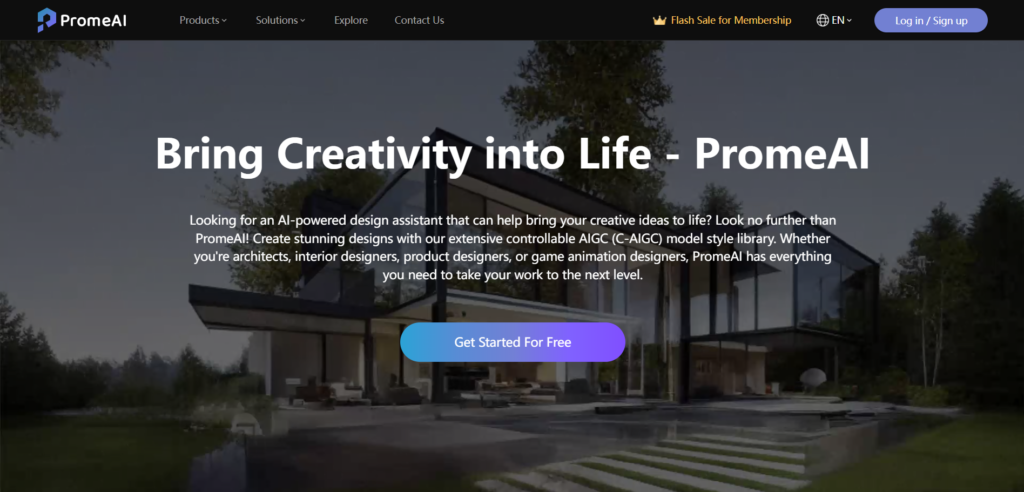
1. PromeAI Unveils Text to Video Feature
PromeAI has been a focal point in the AI field, thanks to its innovative image generation technology. Recently, it achieved another significant milestone with the release of its AI text to video technology.
PromeAI’s text to video feature aims to revolutionize traditional video editing by developing high-quality video generation techniques. The current beta version of the video generation tool can produce smooth and top-notch videos, encompassing not only realistic motion scenes but also various other styles such as animation, anime, and cinematic styles. This advancement marks a significant step forward in the industry.
2. The Rising Trend of Text to Video
The recent release of Image to Video functionality by PromeAI reflects the growing wave of AI-generated content shifting from text and images towards more complex forms like videos and live streaming. This transition has spurred a surge in breakthrough products and technologies in the field, intensifying the competition.
Notable advancements include Meta’s Emu model, Pika Labs’ 1.0 release, StabilityAI‘s Stable Video Diffusion, as well as earlier developments like AnimateDiff and Runway’s Gen2. All of these innovations empower users to generate video content based on text input. This dynamic landscape marks an exciting era of text-driven video generation.

3. The Challenges of Text to Video Generation
There are several challenges that currently restrict the progress of video generation from text, including massive computational requirements, scarcity of high-quality datasets, controllability, and customization for multiple scenarios:
Computational Demands: While text-to-image generation produces a single image per iteration, mainstream text to video methods typically generate videos ranging from 2 to 4 seconds in length. To create a short video with rich and smooth content, it requires generating around 24 frames per second, resulting in 96 images. For a one-minute HD video, this number increases to 60 frames per second, resulting in 3,600 images, assuming no trimming is needed. However, if editing is required, even more images need to be generated. Currently, the prevailing approach is to generate 8 frames per second and interpolate the remaining frames using frame interpolation algorithms. Nonetheless, text to video generation significantly increases resource consumption compared to text-to-image generation.
Content Coherence: Text to video generation is not simply about quickly playing a sequence of images. It requires both diversity in content and smoothness in playback. This means that video generation must ensure the coherence and continuity of each frame, maintaining consistency with the preceding and subsequent frames. Failure to achieve this can result in visual discontinuities or “glitches” during video playback, necessitating a robust AI frame interpolation algorithm.
Cross-Frame Consistency: Maintaining consistency of elements (characters, scenes) across different frames is crucial. Aspects such as clothing, facial expressions, and actions of characters should be continuous and consistent in each frame. However, ensuring this consistency is challenging, and often leads to unnatural image errors or artifacts, rendering some frames unusable.
Meaningful Actions: Generating videos with complex interactions between characters and objects requires understanding the context and logic of actions, as well as adherence to human anatomical structures, to produce natural and realistic dynamic videos.
Demand for Large and High-Quality Datasets: Generating high-quality videos not only requires visual clarity but also content richness, encompassing various actions and scenes.
Resolution and Clarity: Higher resolutions and improved image quality, such as color, contrast, and brightness, increase the computational demands.
Addressing these challenges will require algorithm optimization, improvements in data quantity and quality, and the utilization of computational resources. As these areas continue to evolve, these hurdles can be overcome, paving the way for further advancements in text to video generation.
4. From Images to Videos: The Rise of Video AI
The emergence of video AI signifies the next phase in the competition within the AI domain. Applications such as chatbots and digital art have already flourished in the AI race. Undoubtedly, these applications continue to evolve in terms of depth, integrating with fields like interior design, architecture, and e-commerce. Simultaneously, as the market becomes saturated with homogeneous developments, it becomes crucial to explore new avenues. This is where video, a technically challenging and less-discussed direction, quietly rises to prominence.
However, it is important to note that videos are also one of the most commonly encountered mediums in our daily lives, including movies, streaming platforms, and short videos. While the existing applications have gained significant traction, the potential of video AI remains largely untapped. By venturing into this uncharted territory, we unlock new possibilities and usher in a new era of technological advancement.
As the competition intensifies, the focus shifts towards harnessing the power of AI to unleash the full potential of video content creation. The convergence of AI and video holds great promise, revolutionizing industries and transforming the way we consume and interact with visual media. Through continuous innovation and breakthroughs in video AI, we are poised to reshape the landscape of entertainment, media, and communication.
In this era of rapid technological advancements, the journey from images to videos marks a significant milestone. It not only reflects the evolving nature of AI competition but also highlights the need to explore new frontiers. As the frequency of video consumption continues to rise, embracing the challenges and opportunities presented by video AI is essential for staying at the forefront of innovation.
5. Business Model and Market Strategy
PromeAI, their business model revolves around providing high-quality and diverse visual content generation services, encompassing both images and videos. Their target audience includes general users, professional creators, and businesses. PromeAI has successfully validated the feasibility and market potential of their business model. Their core advantage lies in their diverse background, comprising not only technical expertise but also artistic and creative talents, as well as marketing professionals. This multidimensional approach allows them to understand and address problems from various perspectives.
6. Future Outlook
The goal is not only to develop high-quality video generation technologies but also to create a new generation of production methods and interfaces, redefining the video production workflow to make it efficient and user-friendly. This entails enhancing video duration, clarity, and content diversity. Looking ahead, PromeAI aims to revolutionize the video creation industry by providing innovative solutions that empower users to unleash their creativity and meet the ever-growing demand for visually compelling content.



